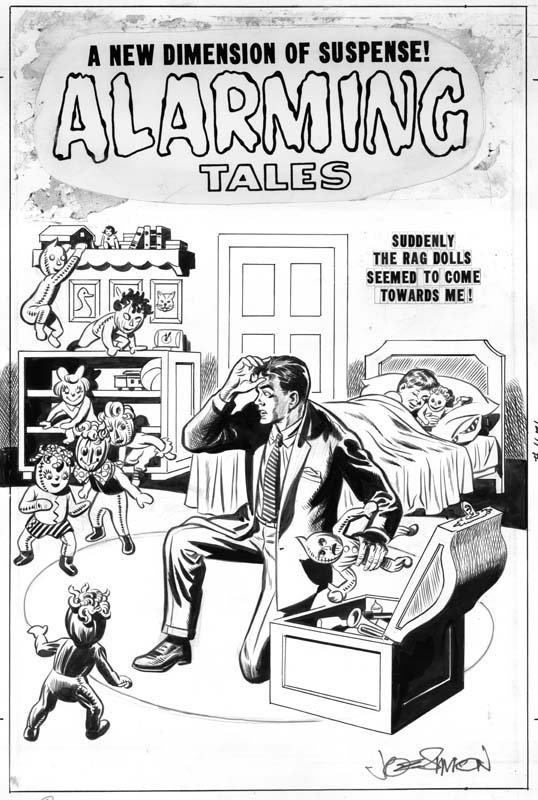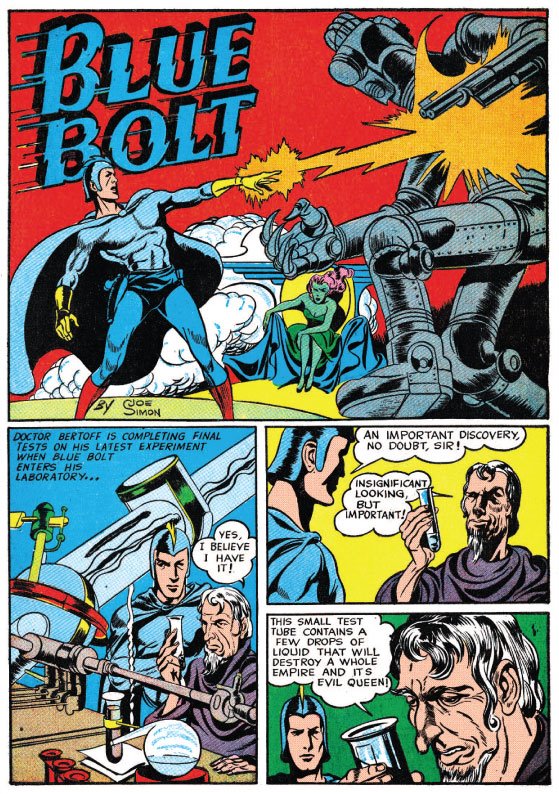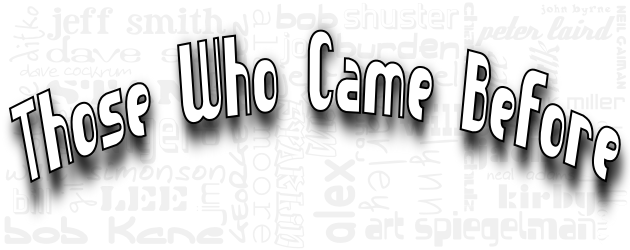Going back to the Golden Age for this month’s Those Who Came Before, we’re taking a look at Joe Simon. Simon created and contributed to many characters during the 1940s, 50s and 60s, including one of the very best the comic world has known. If you love Captain America (Steve Rogers), and why wouldn’t you, you’ll appreciate Joe Simon. He and Jack Kirby, with whom he frequently teamed, created the Captain in 1940. Captain America Comics #1, published in March of that year, introduced the world to one of the greatest heroes fiction has ever known, the Super-Soldier, Steve Rogers.
Simon’s beginning
Joe Simon was born in 1913, the son of a tailor. Simon was raised in Rochester, NY, where he was art director of his high school newspaper and yearbook. It was during this time that he first made money from his artwork, with a university buying the rights to publish some of his art from the school’s yearbook.
In 1932 Simon was hired on at the Rochester Journal American, where he retouched photos, among other things. A couple of years later he moved to the Syracuse Herald, though he stayed in the field of art. Simon followed that with an art director position at the Syracuse Journal American. Simon was really moving along with his art career by this time, and he hadn’t strayed from the newspaper business just yet.
Newspapers however, were being threatened at that time by radio broadcasting, and the advertising dollars this new medium was seeking to siphon away from print media. By 1938 he was doing freelance work in New York, including more photo retouching work in the employ of Paramount Pictures. He also did some magazine illustrations during this time. Things were about to really take off for the comics business in 1938; Action Comics #1, and Superman, came along in June of that year, and changed everything.
Comics
Simon didn’t jump on the comic book bandwagon immediately. He was interested in sports illustration, and boxing. He was enjoying being close to that world thanks to his newspaper ties. His first real venture into the comics business was at Funnies, Inc., with a seven page western. At that time he was making $5 a page, not too bad considering it was 70 years ago. Shortly after his first assignment was complete, Funnies, Inc. requested that Simon create a character similar to the original Human Torch, a Timely Comics property. He got to work on creating a fire-powered hero.

Simon’s first super hero creation was the Fiery Mask, a character with flame powers, debuting in Daring Mystery Comics #1 in January 1940. Around this time he also created a sci-fi hero, the Blue Bolt. It was at this point in his career that he met Jacob Kurtzberg, better known to us today as Jack Kirby.
Teaming with Jack Kirby
Despite their differing origins, Kirby was from the rough Lower East Side of Manhattan, the two young men had things in common. Both were the sons of tailors. Both were Jewish-Americans. They both loved art. And they both were about to embark on a roller coaster journey into the burgeoning field of comic books.
Simon and Kirby teamed up for more than a decade, and became very close friends. After World War II (in which they both served), they even bought homes across the street from one another on Long Island. This made their collaboration easier, since by that time they were working from home. At the time of their initial meeting, Kirby was working for comic book publisher and newspaper syndicator Fox Feature Syndicate. Simon recounts that meeting…
I had a suit and Jack thought that was really nice. He’d never seen a comic-book artist with a suit before. The reason I had a suit was that my father was a tailor. Jack’s father was a tailor too, but he made pants! Anyway, I was doing freelance work and I had a little office in New York about ten blocks from DC’s and Fox’s offices, and I was working on Blue Bolt for Funnies, Inc. So, of course, I loved Jack’s work and the first time I saw it I couldn’t believe what I was seeing. He asked if we could do some freelance work together. I was delighted and I took him over to my little office. We worked from the second issue of Blue Bolt…
— Joe Simon in 1998
It figures that Kirby hadn’t seen a comic book artist in a suit by that time, since the business was still considered illegitimate by many. This view of comics continued on even after the war. Simon remembers that it still wasn’t fashionable to be a comic book artist at that time, so he circulated the rumor that he was a bookie. Imagine wanting your neighbors to think you’re a bookie instead of an artist, but that’s the world they lived in. You might be surprised that in post-WW II America –and after the successes of Superman, Batman, and many others– people still weren’t giving them their due, but that was a very tough time for comics and their creators.

Captain America
Simon and Kirby continued to work together, and left Fox shortly after they joined forces. The pair ended up working for pulp magazine publisher Martin Goodman, and his company, Timely Comics. Timely would later become Atlas Comics, and by the 1960s it was Marvel Comics. It was here where they created Captain America, introducing him to the world in Captain America Comics #1.
It wasn’t just Captain America that catapulted them into comic stardom. The pair brought things to the table artistically that were groundbreaking. Dynamic visual perspectives, exaggerated action, cinematic styling, center spreads, and more. It’s said that they rewrote the book on comic art. I’m sure that cover image of Cap giving Hitler a walloping fist to the kisser was a fan favorite, regardless of the reader’s artistic sensibilities. Captain America Comics is credited with containing the first full-page panel as well. Thank goodness for action that takes up an entire page!
Captain America was wildly successful. The first issue of Captain America Comics sold out in days, and the second had a print run of over a million copies. Quite an accomplishment, considering those numbers were right up there with Captain Marvel and Superman.
Their innovations weren’t just with Captain America. They did some early work on Captain Marvel (who ended up outselling Superman) for Fawcett Comics. They became very popular with fans in a short period of time. The futures of these two men were intertwined for several years following the success of Captain America.
Troubles
Simon and Kirby’s popularity with readers didn’t help too much when it came to their financial compensation for Captain America. Having made a deal with Goodman to get 15% of the profits as well as salaried positions with the company, they should have been in good shape. Simon however, believed that Goodman wasn’t paying them their full share of the agreed upon wages, and began looking elsewhere for employment. He and Kirby made a deal with National Comics (a precursor of DC Comics) that would earn the two of them a combined $500 a week. That was a whole lot of money back then, and it was much more than the $75 – $80 a week they had each been making with Timely. They ended up leaving Timely after only 10 issues of Captain America Comics. Ten issues however, was good enough to make the pair two of the most sought after comic artists of their day.
National Comics
Once they got settled in over at National Comics, they found success once again. They took over the Sandman strip in Adventure Comics, and created a few new ones. One of these creations was the Manhunter, a big game hunter turned crime fighter. They went on to give readers a couple of “kid gang” comics like Boy Commandos, and the Newsboy Legion. It was July 1942 when they began the Boy Commandos strip, and the ongoing series, which began later that year, sold over a million copies a month and became National’s third best-selling title.
They had done it once again, with another million-copy-a-month title under their belts. This prosperity would soon have to be interrupted, just as it was for many in all walks of American life.
World War II
Many comic creators were being drafted into the service, including Kirby. Simon however, didn’t want to be drafted. No, he didn’t retreat to Canada, he faced it head on and joined up, opting for the Coast Guard. Knowing that Simon and Kirby were probably going to be gone for a while, their editor wanted them to produce enough material to run while they were away. They got busy, hiring extra help, and turning out plenty of work to be published while they were overseas. This didn’t completely put a halt to Simon’s involvement in comics. During the war he worked packaging comics for the Coast Guard’s Combat Art Corps in D.C. How about that, he got to work with comics while serving in the armed forces.
I think it’s pretty interesting that these two were going to be part of the fight. They were actually going to be joining the war effort, the very same that Captain America had been in every month. How many comic creators have had the opportunity to experience even a small bit of the super hero adventures they put their creations through on a monthly basis? Quite an experience indeed!
After the war
Both men survived the war, and by 1945 were back home and busy once more. It was during this post-war time that they found themselves married, and living across the street from one another. Their partnership was still going strong, and hadn’t waned at all during the war. For example, before Simon was even out of the service, he had negotiated another deal for the two of them with Al Harvey of Harvey Comics.

They were with Harvey through the early 1950s, and continued to create new characters and titles. The popularity of super hero comics had declined since the pre-war years, and the two men adapted. Their creations included kid gang books Boy Explorers Comics, and Boys Ranch, but they didn’t abandon the super hero. They also created Stuntman, and Captain 3-D during that time.
They did freelance work with Crestwood Publications and Hillman Periodicals. At this point in their careers, their work was about to make a definite shift.
Young Romance
Simon and Kirby created what is thought to be the very first romance comic, Young Romance. This title was their biggest hit in years. Simon had transplanted the idea of a romance magazine, like Macfadden Publications’ True Story, into the comic format. It was a huge success. This time, Simon secured a deal worth 50% of the title’s profits. Certainly a good idea, since Young Romance took off like a rocket after its first publication in 1947. There were millions of copies sold. There were spin-offs, and copies from several other publishers. The romance comic was born, and everyone wanted a piece of the pie. A little later on Simon and Kirby themselves added Young Love to compliment Young Romance, and the two titles together sold 2 million copies per month.
Mainline Publications
In 1953 the pair formed a comic book publishing company called Mainline Publications. During this time they created a western hero named Bullseye, and another patriotic super hero, the Fighting American. This company was rather short-lived, and was done in 1956.
After Kirby
After the downfall of Mainline Publications, the Simon & Kirby partnership was pretty much over. The industry was suffering from low sales, bad publicity, and the censorship of the Comics Code Authority.
Joe Simon went into commercial art and advertising for a time. He also worked on Sick, a competitor of Mad magazine, for several years. He and Kirby reunited briefly in 1959 at Archie Comics, where among other things, they created the Fly. They teamed up again in 1966, doing work for Harvey Comics, on the Fighting American.
In 1968 Simon did some work for DC on Brother Power the Geek. The early 1970s brought more work for DC with Prez, a four issue mini-series about the first teenaged president of the United States.
Simon teamed up with Kirby once again in 1974 to write the first issue of a series introducing a new incarnation of the Sandman. Simon continued to do some comic work here and there during the 1970s.
Nowadays
In recent years Simon has been painting, and working with some of his original covers from decades ago. Simon was a pretty popular guy a couple of years ago when Captain America’s death was published by Marvel Comics.
I never would have guessed that the guy who created Captain America would later go on to do romance comics, and be so successful at them. Joe Simon certainly has led an interesting life, and a successful career. One thing I thought was interesting about him is his view of the villain in a story.
We’d have the main character be second banana to the villain, and that’s how Captain America came out. I picked Adolph Hitler as the ideal villain. He had everything that Americans hated, and he was a clown with the funny moustache, yet guys were ready to jump out of planes for him. He was the first choice, and his antagonist would have to be our hero, and we’d put a flag on the guy and have Captain America.
— Joe Simon
Check out some more of Simon’s work…



Joe Simon is one of those guys whose talent and hard work helped pave the way for the industry we have today. Would we have such a wide variety of quality comics to choose from today if it weren’t for the work of guys like Joe Simon? I seriously doubt it.
I know that Mr. Simon is enjoying the return of his creation in Marvel’s books, he certainly deserves to see Steve Rogers alive and in action once again in a monthly book.
Eli Anthony
eli@comicattack.net





Joe Simon’s a native of Rochester, NY? That’s awesome! Buffalo, my hometown, is about an hour away!
It’s definitely crazy to accept that these guys had to pretend to be professionals of something else as comics were frowned upon during their day. I can’t even imagine a world without comics.
It’s very cool that Kirby and Simon were going to go fight the same battle Cap fought in the pages of their comic book. I wonder what they were thinking at that time…
I also didn’t know how they revolutionized comic book lay outs. It’s such a simple thing really, but easy to over look its importance.
Love that Last Supper piece! It totally trumps Dogs Playing Poker.
Awesome article Eli! JS is one of those guys who everyone should look up to.
Yeah, he really handled himself well in some of those situations back then. Things like including Kirby in his negotiations with Al Harvey for work after the war really show the character of the man.
Also, something I couldn’t include in the column before it went up (due to the NY Times website blocking me until now):
This came from a 2008 interview Simon did with the NY Times. As far as Simon’s feelings about Bucky as Cap, and the direction the character took after Steve’s death
“The new costume, with the pistol and knife, and the old shield design going down to his privates, that’s not Captain America…” — Joe Simon
I know plenty of people love Bucky as Cap, but I for one always felt that nobody should be Cap except for Steve Rogers. With Bucky, it’s like the Captain America character lost that wholesome upstanding quality that it never lacked in Steve.
That’s something I always appreciated about Cap, and it’s nice to know Mr. Simon does too. For example, after reading… oh I don’t know, some of Frank Miller’s stuff, it’s a very refreshing change to have a hero who takes down the bad guys, yet won’t hesitate to tell a young man to watch his language.
You gotta love Steve Rogers.
Pingback: The 2010 Eisner Award Nominations
Pingback: Those Who Came Before: Neal Adams